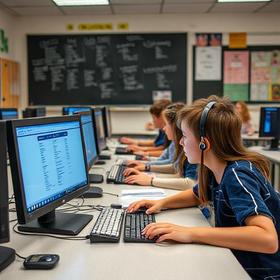Algonquin Regional High School is a public high school located in Northborough, Massachusetts, United States. The school serves the students of the Northborough-Southborough Regional School District comprising both Northborough and neighboring Southborough.
Serving 1,194 students in grades 9-12, Algonquin Regional High School ranks in the top 5% of all schools in Massachusetts for overall test scores (math proficiency is top 1%, and reading proficiency is top 1%).
The percentage of students achieving proficiency in math is 87% (which is higher than the Massachusetts state average of 42%). The percentage of students achieving proficiency in reading/language arts is 78% (which is higher than the Massachusetts state average of 44%).
The student-teacher ratio of 11:1 is lower than the Massachusetts state level of 12:1.
Minority enrollment is 33% of the student body (majority Asian), which is lower than the Massachusetts state average of 47% (majority Hispanic).
Quick Facts (2025-26)
- Grades: 9-12
- Enrollment: 1,194 students
- Student-Teacher Ratio: 11:1
- Minority Enrollment: 33%
- Graduation Rate: 98% (Top 10% in MA)
- Overall Testing Rank: Top 5%
- Math Proficiency: 87% (Top 1%)
- Reading Proficiency: 78% (Top 5%)
- Science Proficiency: 79% (Top 5%)
- Source: National Center for Education Statistics (NCES), MA Dept. of Education
Top Rankings
Algonquin Regional High School ranks among the top 20% of public schools in Massachusetts for:
Category
Attribute
Overall Rank
Math Proficiency
Reading/Language Arts Proficiency
Science Proficiency
Graduation Rate
School Overview
Algonquin Regional High School's student population of 1,194 students has declined by 17% over five school years.
The teacher population of 109 teachers has declined by 6% over five school years.
Grades Offered
Grades 9-12
(Supplemental Virtual)
(Supplemental Virtual)
Total Students
1,194 students
Gender %
Total Classroom Teachers
109 teachers
Year Founded
1959
Colors
Maroon, Gold
School Mascot
Titans
School Rankings
Algonquin Regional High School ranks within the top 5% of all 1,626 schools in Massachusetts (based off of combined math and reading proficiency testing data).
The diversity score of Algonquin Regional High School is 0.52, which is less than the diversity score at state average of 0.65. The school's diversity has stayed relatively flat over five school years.
Overall Testing Rank
#21 out of 1626 schools
(Top 5%)
(Top 5%)
Math Test Scores (% Proficient)
87%
42%
Reading/Language Arts Test Scores (% Proficient)
78%
44%
Science Test Scores (% Proficient)
79%
44%
Student-Teacher Ratio
11:1
12:1
American Indian
n/a
n/a
Asian
16%
7%
Hispanic
10%
25%
Black
2%
10%
White
67%
53%
Hawaiian
n/a
n/a
Two or more races
5%
5%
All Ethnic Groups
Graduation Rate
98%
90%
Participates in the National School Lunch Program (NSLP)
Yes
Eligible for Free Lunch
7%
35%
Eligible for Reduced Lunch
1%
4%
School Statewide Testing
School District Name
Source: National Center for Education Statistics (NCES), MA Dept. of Education
School Notes
- School Mascot: Titans
Profile last updated: 02/09/2025
Frequently Asked Questions
What is Algonquin Regional High School's ranking?
Algonquin Regional High School is ranked #21 out of 1,626 schools, which ranks it among the top 5% of public schools in Massachusetts.
What schools are Algonquin Regional High School often compared to?
Algonquin Regional High Schoolis often viewed alongside schools like Westborough High School by visitors of our site.
What percent of students have achieved state testing proficiency in math and reading?
87% of students have achieved math proficiency (compared to the 42% MA state average), while 78% of students have achieved reading proficiency (compared to the 44% MA state average).
What is the graduation rate of Algonquin Regional High School?
The graduation rate of Algonquin Regional High School is 98%, which is higher than the Massachusetts state average of 90%.
How many students attend Algonquin Regional High School?
1,194 students attend Algonquin Regional High School.
What is the racial composition of the student body?
67% of Algonquin Regional High School students are White, 16% of students are Asian, 10% of students are Hispanic, 5% of students are Two or more races, and 2% of students are Black.
What is the student-teacher ratio of Algonquin Regional High School?
Algonquin Regional High School has a student ration of 11:1, which is lower than the Massachusetts state average of 12:1.
What grades does Algonquin Regional High School offer ?
Algonquin Regional High School offers enrollment in grades 9-12 (Supplemental Virtual).
What school district is Algonquin Regional High School part of?
Algonquin Regional High School is part of Northboro-Southboro School District.
School Reviews
5 10/10/2025
Very nice/clean/well-maintained. Principal is super nice guy. All the extracurricular activities you could imagine. Course work is challenging - makes me feel ready for college. I love it here! Senior year is going great :)
Review Algonquin Regional High School. Reviews should be a few sentences in length. Please include any comments on:
- Quality of academic programs, teachers, and facilities
- Availability of music, art, sports and other extracurricular activities
Recent Articles

Cybersecurity in U.S. Public Schools 2025: Risks, Policies & Protection
Explore the 2025 state of cybersecurity in U.S. public schools, updated data, expert insights, policy moves, and how schools and families can stay safe.

The Rise of STEM in Public Schools: 2025 Update
Explore how STEM is transforming U.S. public schools in 2025鈥攖rends, policies, programs, and what parents and educators should know.

How Public Schools Support Mental Health in 2025
Explore how U.S. public schools are supporting student mental health in 2025鈥攑rograms, results, challenges and strategies for educators, parents and policymakers.





